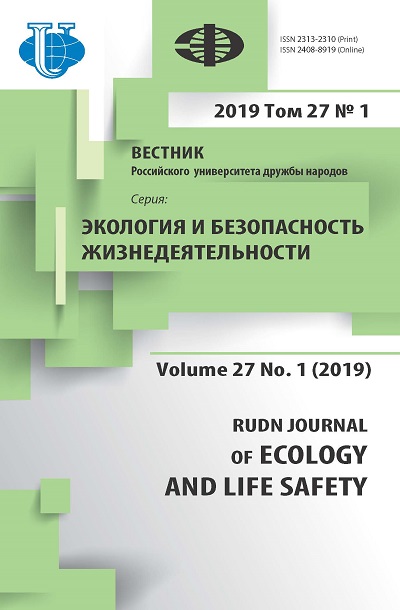The using of ecological properties of plant-hyperaccumulants for reducing man-made load on adjacent to the Moscow Domodedovo Airport territories
- Authors: Soltanov S.K.1
-
Affiliations:
- Moscow State Regional University
- Issue: Vol 27, No 1 (2019)
- Pages: 51-58
- Section: Ecology
- URL: https://journals.rudn.ru/ecology/article/view/22109
- DOI: https://doi.org/10.22363/2313-2310-2019-27-1-51-58
Cite item
Full Text
Abstract
The article presents the chemical elements with the highest content of gross and mobile forms in the soil solution of ground near the aerodrome area of the Moscow Domodedovo Airport. The most important types of plant-hyperaccumulants, which can stabilize the geochemical situation around airport are considered in the paper. The types of plants which can sorb in shortest time some metals-pollutants are brought together in tables. Thanks to the research, the features of pollutants of the soils near the aviation hub are defined. Part of the study had become the development recommendations on reduction of environmental burden on adjacent to the airport lands through the creation of phytobuffers.
About the authors
Seymour Kh Soltanov
Moscow State Regional University
Author for correspondence.
Email: sej99@yandex.ru
graduate student
24 Very Voloshinoy St., Mytischi, 141014, Russian FederationReferences
- Golubev SV. Soil contamination of the Domodedovo District with heavy metals (Dissertation of Candidate of Geographical Sciences). Moscow; 2007.
- Ecology (air transport): a handbook for the study of discipline and the performance of tests. Moscow: MSTU GA Publ.; 2015.
- Titov AF, Talanova VV, Kaznina NM. Physiological basis of plant resistance to heavy metals: study guide. Petrozavodsk: Karelian Research Center of the Russian Academy of Sciences; 2011.
- Kaigorodov RV. (comp.) Resistance of plants to chemical pollution: textbook. Perm; 2010.
- Titov AF, Talanova VV, Kaznina NM, Laydinen GF. Plant resistance to heavy metals. Petrozavodsk: Karelian Research Center of the Russian Academy of Sciences; 2007.
- Lebedeva EG, Sharapova NV, Sviridov OA, Revkova EG, Vetherkova ZA, Krasikov SI. Methods of protecting humans from exposure to priority pollutants: educational and methodical manual. Orenburg: Orenburg State Institute of Management; 2011.
- Methods of analysis of NSAM No. 500-MS. Determination of the elemental composition of nitrate and ammonium acetate extracts from soils using inductively coupled plasma mass spectrometry.
- Belobrov VP, Golubev SV. Technogenic pollution of soil in the zone of influence of the Domodedovo airport. Agrochemical messenger. 2007;(5): 26–28.
- Method of analysis of NSAM No. 499-AES/MS. Determination of the elemental composition of rocks, soils, soils and bottom sediments by atomic emission with inductively coupled plasma and mass-spectral to inductively coupled plasma methods.
- The method of analysis of HCAM No. 480-X. Determination of the elemental composition of natural and drinking water by the ICP-MS method (edition of 2006, amendment No. 1 of April 13, 2011).
- Toxicology of young fission products. p. 23. Available from: https://poznayka.org/ s30420t1.html (accessed 10.12.2018).
- Zhalsaraeva DM. Side effects of yttrium sulfate (Dissertation of Candidate of Medical Sciences). Ulan-Ude; 2002.
- Small enterprise regional toxicological and hygienic information center “TOXI”. Available from: http://toxi.dyndns.org/base/nonorganic/TR.htm (accessed 10.11.2018).
- Biogeochemical potential and health. p. 8. Available from: https://pandia.ru/text/79/ 494/2935-8.php (accessed 10.11.2018).
- Mamyrbaev AA. Toxicology of chromium and its compounds: monograph. Aktobe; 2012. [16] Bingam FT, Costa M, Eichenberger E. et al. Some Issues of Toxicity of Metal Ions. Moscow: Mir Publ.; 1993.
- Kaplin VG. Fundamentals of ecotoxicology: textbook. Moscow: KolosS Publ.; 2006. [18] Kathal R, Malhotra P, Kumar L, Uniyal PL. Phytoextraction of Pb and Ni from contaminated soil Brassica juncea L. J. Environ Anal. Toxicol. 2016;6(5): 394. DOI: 10.4172/ 2161-0525.1000394.
- Galiulin R, Galiulina RA. Soil removal from heavy metals with the help of plants. Herald of the Russian Academy of Sciences. 2008;78(3): 247–249.
- MU 2.1.7.730-99. Hygienic assessment of the quality of the soil populated areas (approved by Ministry of Health of the Russian Federation, 7 February 1999).
- GN 2.1.7.2041-06. The maximum permissible concentration (MPC) of chemicals in the soil (amended on 26 June 2017).
















